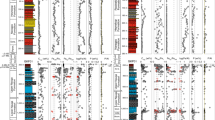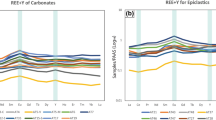Abstract
Sapropels—organic-matter rich layers—are common in Neogene sediments of the eastern Mediterranean Sea. The formation of these layers has been attributed to climate-related increases in organic-matter production1,2,3 and increased organic-matter preservation due to oxygen depletion in more stagnant bottom waters2,3. Here we report that eastern Mediterranean Pliocene sapropels4 contain molecular fossils of a compound (isorenieratene) known to be synthesized by photosynthetic green sulphur bacteria, suggesting that sulphidic (euxinic)—and therefore anoxic—conditions prevailed in the photic zone of the water column. These sapropels also have a high trace-metal content, which is probably due to the efficient scavenging of these metals by precipitating sulphides in a euxinic water column. The abundance and sulphur-isotope composition of pyrite are consistent with iron sulphide formation in the water column. We conclude that basin-wide water-column euxinia occurred over substantial periods during Pliocene sapropel formation in the eastern Mediterranean Sea, and that the ultimate degradation of the increased organic-matter production was strongly influential in generating and sustaining the euxinic conditions.
This is a preview of subscription content, access via your institution
Access options
Subscribe to this journal
Receive 51 print issues and online access
$199.00 per year
only $3.90 per issue
Buy this article
- Purchase on Springer Link
- Instant access to full article PDF
Prices may be subject to local taxes which are calculated during checkout


Similar content being viewed by others
References
Calvert, S. E., Nielsen, B. & Fontugne, M. R. Evidence from nitrogen isotope ratios for enhanced productivity during formation of eastern Mediterranean sapropels. Nature 359, 223–225 (1992).
Rossignol-Strick, M., Nesteroff, W., Olive, P. & Vergnaud-Grazzini, C. After the deluge: Mediterranean stagnation and sapropel formation. Nature 295, 105–110 (1982).
Rohling, E. J. Review and new aspects concerning the formation of eastern Mediterranean sapropels. Mar. Geol. 122, 1–28 (1994).
Emeis, K.-C. et al. Paleoceanography and sapropel introduction.In Proc. ODP Init. Rep. Leg 160, 21–28 (1996).
Lourens, L. J. et al. Evaluation of the Plio-Pleistocene astronomical timescale. Paleoceanography 11, 391–413 (1996).
Liaaen-Jensen, S. in The Photosynthetic Bacteria (eds Clayton, R. K. & Sistrom, W. R.) 233–247 (Plenum, New York, (1978)).
Quandt, I., Gottschalk, G., Ziegler, H. & Stichler, W. Isotope discrimination by photosynthetic bacteria. FEMS Microbiol. Lett. 1, 125–128 (1977).
Summons, R. E. & Powell, T. G. Chlorobiaceae in Palaeozoic seas revealed by biological markers, isotopes and geology. Nature 319, 763–765 (1986).
Kohnen, M. E. L. et al. Recognition of paleobiochemicals by a combined molecular sulfur and isotope geochemical approach. Science 256, 358–362 (1992).
Sinninghe Damsté, J. S., Wakeham, S. G., Kohnen, M. E. L., Hayes, J. M. & de Leeuw, J. W. A6,000-year sedimentary molecular record of chemocline excursions in the Black Sea. Nature 362, 827–829 (1993).
Hartgers, W. A. et al. Evidence for only minor contributions from bacteria to sedimentary organic carbon. Nature 369, 224–227 (1994).
Repeta, D. J., Simpson, D. J., Jørgensen, B. B. & Jannasch, H. W. Evidence for anoxygenic photosynthesis from the distribution of bacteriochlorophylls in the Black Sea. Nature 342, 69–72 (1989).
Nijenhuis, I. A., Brumsack, H.-J. & de Lange, G. J. The trace element budget of the Eastern Mediterranean during Pliocene sapropel formation.In Proc. ODP Sci. Res. Leg 160 199–206 (1998).
Arthur, M. A., Brumsack, H.-J., Jenkyns, H. C. & Schlanger, S. O. In Cretaceous Resources, Events and Rhythms (eds Ginsburg, R. N. & Beaudoin, B.) 75–119 (Kluwer Academic, Dordrecht, (1990)).
Passier, H. F., Middelburg, J. J., van Os, B. J. H. & de Lange, G. J. Diagenetic pyritisation under eastern Mediterranean sapropels caused by downward sulphide diffusion. Geochim. Cosmochim. Acta 60, 751–763 (1996).
Passier, H. F., Middelburg, J. J., de Lange, G. J. & Böttcher, M. E. Modes of sapropel formation in the eastern Mediterranean: some constraints based on pyrite properties. Mar. Geol. 153, 199–219 ((1999)).
Passier, H. F., Middelburg, J. J., de Lange, G. J. & Böttcher, M. E. Pyrite contents, microtextures, and sulfur isotopes in relation to formation of the youngest eastern Mediterranean sapropel. Geology 25, 519–522 (1997).
Canfield, D. E., Lyons, T. W. & Raiswell, R. Amodel for iron deposition to euxinic Black Sea sediments. Am. J. Sci. 296, 818–834 (1996).
Kempe, S., Diercks, A.-R., Liebezeit, G. & Prange, A. in Black Sea Oceanography (eds Izdar, E. & Murray, J. W.) 89–110 (Kluwer Academic, Dordrecht, (1991)).
Canfield, D. E. & Thamdrup, B. The production of 34S-depleted sulfide during bacterial disproportionation of elemental sulfur. Science 266, 1973–1975 (1994).
Fry, B. et al. Stable isotope studies of the carbon, nitrogen and sulfur cycles in the Black Sea and the Cariaco Trench. Deep-Sea Res. 38, 1003–1019 (1991).
Rossignol-Strick, M. Mediterranean Quaternary sapropels, an immediate response of the African monsoon to variation of insolation. Palaeogeogr. Palaeoclimatol. Palaeoecol. 49, 237–263 (1985).
Hilgen, F. J. Astronomical calibration of Gauss to Matuyama sapropels in the Mediterranean and implication for the geomagnetic polarity time scale. Earth Planet. Sci. Lett. 104, 226–244 (1991).
Arthur, M. A. et al. Varve calibrated records of carbonate and organic carbon accumulation over the last 2000 years in the Black Sea. Glob. Biogeochem. Cycles 8, 195–217 (1994).
Béthoux, J. P. Oxygen consumption, new production, vertical advection and environmental evolution in the Mediterranean Sea. Deep-Sea Res. 36, 769–781 (1989).
Dymond, J., Suess, E. & Lyle, M. Barium in deep-sea sediment: a geochemical proxy for paleoproductivity. Paleoceanography 7, 163–181 (1992).
Falkner, K. K. et al. The behavior of barium in anoxic marine waters. Geochim. Cosmochim. Acta 57, 537–554 (1993).
François, R., Honjo, S., Manganini, S. J. & Ravizza, G. E. Biogenic barium fluxes to the deep sea: Implications for paleoproductivity reconstruction. Glob. Biogeochem. Cycles 9, 289–303 (1995).
Dean, W. E., Gardner, J. V. & Piper, D. Z. Inorganic geochemical indicators of glacial-interglacial changes in productivity and anoxia on the California continental margin. Geochim. Cosmochim. Acta 61, 4507–4518 (1997).
Bosch, H.-J., Sinninghe Damsté, J. S. & de Leeuw, J. W. Molecular paleontology of Eastern Mediterranean sapropels: evidence for photic zone euxinia.In Proc. ODP Sci. Res. Leg 160, 285–295 (1998).
Acknowledgements
We thank S. McNab for linguistic advice; G. Nobbe, H. de Waard and T. Zalm for analytical assistance; and The Ocean Drilling Program and Leg 160 shipboard participants for their co-operation. This is a publication of the Netherlands Research School of Sedimentary Geology. This work was supported in part by the Netherlands Organization for Scientific Research (NWO) and the European Union Marine Science and Technology (MAST) programme.
Author information
Authors and Affiliations
Corresponding author
Rights and permissions
About this article
Cite this article
Passier, H., Bosch, HJ., Nijenhuis, I. et al. Sulphidic Mediterranean surface waters during Pliocene sapropel formation. Nature 397, 146–149 (1999). https://doi.org/10.1038/16441
Received:
Accepted:
Issue Date:
DOI: https://doi.org/10.1038/16441
This article is cited by
-
Organic carbon burial in Mediterranean sapropels intensified during Green Sahara Periods since 3.2 Myr ago
Communications Earth & Environment (2022)
-
Micro-trace fossils reveal pervasive reworking of Pliocene sapropels by low-oxygen-adapted benthic meiofauna
Nature Communications (2015)
-
Cyanobacteria as a trigger for increased primary productivity during sapropel formation in the Baltic Sea—a study of the Ancylus/Litorina transition
Journal of Paleolimnology (2007)
-
Comprehensive geochemical identification of highly evolved marine carbonate rocks as hydrocarbon-source rocks as exemplified by the Ordos Basin
Science in China Series D (2006)
-
The transition to a sulphidic ocean ∼ 1.84 billion years ago
Nature (2004)
Comments
By submitting a comment you agree to abide by our Terms and Community Guidelines. If you find something abusive or that does not comply with our terms or guidelines please flag it as inappropriate.



